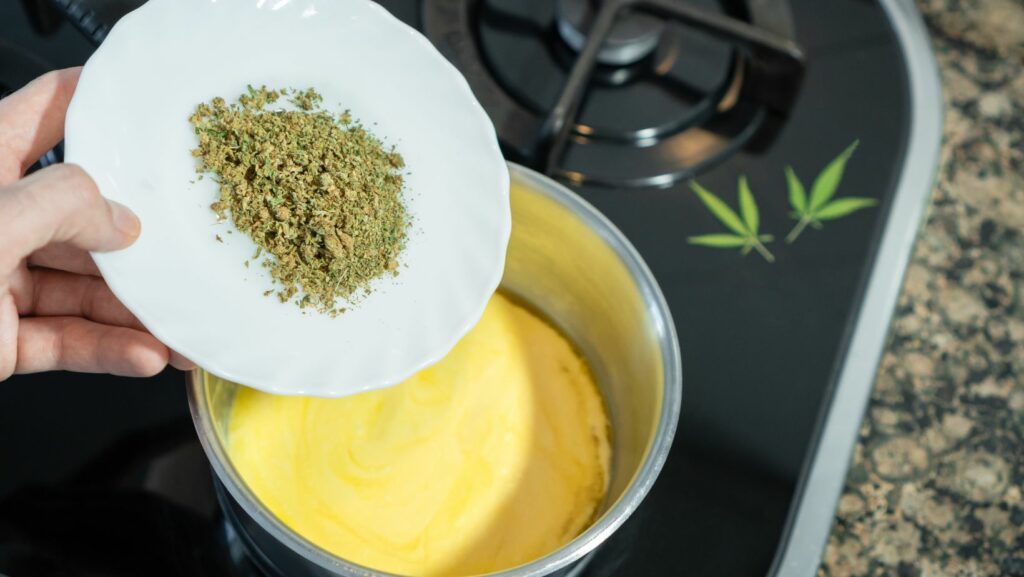
The culinary world has witnessed a remarkable evolution with the introduction and growing acceptance of cannabis as a cooking ingredient. Once a niche concept, cooking with cannabis has now entered mainstream culinary culture, driven by a desire for experimentation and the recognition of cannabis’s unique flavors and therapeutic properties. This trend is not just about indulging in the psychoactive effects of THC but also about exploring the gastronomic potential of cannabis as a herb and spice.
Restaurants in regions where cannabis is legal are leading the charge, offering gourmet cannabis-infused dishes that showcase the plant’s versatility. At home, culinary enthusiasts are experimenting with cannabis-infused oils, butter, and tinctures to add a twist to traditional recipes. This trend coincides with the growing interest in holistic wellness, with cannabis-infused foods offering a more health-conscious method of consumption compared to smoking.
The appeal of cooking with cannabis lies in its ability to infuse dishes with not only unique flavors but also its therapeutic benefits. THC and CBD, the primary cannabinoids in cannabis, can transform a regular meal into one that relieves stress, enhances mood, or aids in digestion and sleep. As the culinary world continues to embrace cannabis, it is becoming an integral part of the gastronomic experience, redefining the boundaries of cooking and eating.
To find out more about marijuana edibles, visit our website – 1-8oz.com
Decarboxylation: Preparing Cannabis for Cooking:
A crucial step in cooking with cannabis is decarboxylation, a process that activates the psychoactive and therapeutic compounds in the plant. Raw cannabis contains THCA and CBDA, the acidic forms of THC and CBD, which do not produce the same effects as their activated counterparts. Decarboxylation involves heating cannabis at a low temperature to convert THCA into THC and CBDA into CBD, thereby unlocking their full potential.
The process of decarboxylation is simple but requires precision. Typically, cannabis is spread out evenly on a baking sheet and heated in an oven at a temperature between 220°F and 245°F for about 30 to 45 minutes. This temperature range is critical; it is too low, and the cannabis won’t fully decarboxylate; it is too high, and the valuable terpenes and cannabinoids could be destroyed.
While decarboxylation primarily aims to activate THC, it also plays a significant role in developing the flavor profile of the cannabis. The heat helps release the terpenes, contributing to the final product’s aroma and taste. This process is essential for any cannabis-infused edible, whether it’s a butter, oil, or alcohol-based tincture.
There are methods to minimize the odor for those concerned about the strong smell that decarboxylation can produce. Enclosing the cannabis in a foil packet before placing it in the oven is one such technique. Additionally, some specialized kitchen gadgets are designed to decarboxylate cannabis with minimal odor.
Proper decarboxylation ensures that when cannabis is added to any recipe, it imparts not only its distinctive flavors but also its full spectrum of effects, making it a key step in the art of cannabis cuisine.
Choosing the Right Strain: Flavor Profiles and Potency:
Selecting the appropriate cannabis strain is a pivotal aspect of cooking with cannabis, as it significantly influences both the flavor and the effects of the dish. Strains vary not only in potency but also in their terpene profiles, which determine the aroma and taste. Understanding these nuances is key to creating a harmonious and enjoyable culinary experience.
When considering potency, THC and CBD levels are the primary focus. High-THC strains are well-suited for those seeking the psychoactive effects of cannabis, whereas high-CBD strains are preferable for those looking for therapeutic benefits without intense psychoactivity. For a balanced experience, hybrid strains with a moderate THC-to-CBD ratio are ideal.
The flavor profile of a strain is largely dictated by its terpenes. For instance, strains with a high limonene content impart a citrusy aroma and are great for dishes that require a fresh, zesty flavor. Myrcene, another common terpene, offers a more earthy and herbal note, suitable for savory dishes. Pinene, with its pine-like aroma, complements dishes that need a woodsy flavor.
Matching the strain’s flavor profile with the intended dish is akin to selecting the right wine to pair with a meal. For example, a strain with fruity terpenes like ‘Blue Dream’ pairs well with desserts or sweet sauces, whereas a strain with savory terpenes like ‘OG Kush’ is more suited for hearty dishes like stews or pasta.
Experimenting with different strains and their unique flavor profiles adds an exciting dimension to cooking, transforming ordinary recipes into gourmet creations infused with the essence of cannabis.
Recipe Section: Share 2-3 Unique Cannabis-Infused Recipes:
Cannabis-Infused Chocolate Brownies:
Decarboxylate 2 grams of a high-THC strain and grind it finely.
Melt ¾ cup of unsalted butter in a saucepan, then mix in the ground cannabis.
Cook on low heat for 45 minutes, stirring occasionally, then strain the butter.
Use this cannabis butter in your favorite brownie recipe, replacing regular butter.
Bake as per the recipe’s instructions for a classic dessert with a twist.
Cannabis-Infused Pesto Pasta:
Decarboxylate 1 gram of a hybrid strain with herbal terpenes.
Blend the decarboxylated cannabis with 2 cups of fresh basil, ½ cup of pine nuts, 2 cloves of garlic, ¾ cup of olive oil, and ½ cup of grated Parmesan cheese to make the pesto.
Cook your preferred pasta and mix it with the freshly made cannabis-infused pesto.
This dish offers a delightful fusion of Italian cuisine with the herbal notes of cannabis.
Cannabis-Infused Guacamole:
Decarboxylate 1 gram of a CBD-dominant strain for a non-psychoactive option.
Mash 3 ripe avocados and mix with the juice of 1 lime, 1 diced tomato, ½ diced onion, and chopped cilantro.
Finely grind the decarboxylated cannabis and sprinkle it into the guacamole, mixing thoroughly.
Serve with tortilla chips for a refreshing appetizer or snack, enhanced with the wellness benefits of CBD.
These recipes demonstrate the versatility of cannabis in cooking, offering options for both THC and CBD enthusiasts. They can be adjusted based on personal preference and the desired potency, allowing for a tailored cannabis culinary experience.
Tips for Cooking with Cannabis: Dosage, Safety, and Storage:
When cooking with cannabis, it’s crucial to approach dosage with caution and precision. Unlike other forms of consumption, edibles take longer to metabolize, resulting in a delayed onset of effects that can last much longer. Start with a low dose, particularly if you’re new to cannabis-infused edibles. For those unfamiliar with their tolerance, beginning with a dose as low as 5 milligrams of THC per serving is advisable. Remember, it’s easy to increase the dose next time but impossible to decrease it once consumed.
Safety in the kitchen extends to handling cannabis responsibly. When cooking, ensure that your workspace is clean and that you’re using equipment dedicated to preparing cannabis-infused products. This reduces the risk of cross-contamination. Additionally, be mindful of the cooking temperature. Overheating cannabis can lead to the loss of beneficial compounds and potentially create an unpleasant taste.
Storage is another critical aspect. Cannabis-infused products should be stored in airtight containers, away from direct sunlight and heat, to preserve their potency and freshness. They should always be clearly labeled and kept out of reach of children and pets. This is not only a safety measure but also ensures that no one consumes them unknowingly.
Lastly, educate anyone consuming your cannabis-infused dishes about their potency and effects. This includes discussing the expected onset time and duration of effects. Responsible consumption and open communication are key to enjoying cannabis-infused cuisine safely and enjoyably.













